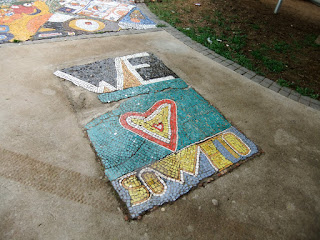
We arrived in Johannesburg on January 17th after a very long flight. From the start in Washington Dulles and onward, our group came together in an organized fashion which made traveling easier and more enjoyable. We were happy that our guides were at the airport on time to take us to our guesthouse. Immediately we were all overwhelmed by the differences and similarities in this new place. For example, one of the first places we saw while driving in our seat belt-less vans called kombis, was a KFC. As the week progressed we had the opportunity to meet with people from many organizations including representatives from the South African Council of Churches, the ANC, the Democratic Alliance, an environmental expert, and an economist specializing on the South African economy. We also were able to visit the Bruma Market and downtown Jo-Burg. Once we made it to the guesthouse, each of us learned the complexities of African internet as we all stumbled to contact our families back home.
The next morning we hit the ground running! We got off to a great start meeting Molefi who would later greatly contribute to our orientation experience. Molefi talked to us about the history of Johannesburg and some important cultural contexts which we needed to know. We focused a lot on the uprising of June 1976 including a visit to the Hector Pieterson museum. On June 1, 1976 after the Apartheid government mandated that Afrikaans (referred to as “the language of the oppressor”) be the official language in schools, many high school students from multiple institutions came together to hold a peaceful protest. The result was a massacre by local police authorities. Hector Peiterson was one casualty of this uprising. This was special because we had the honor of meeting Hector Pieterson’s older sister who talked to us about her personal experiences during the uprising. We then went on a tour of the areas involved in the uprising and the path the students marched. It is surprising how high school aged students were able to generate this call for social change without involving their parents in any way. It made us think about where social change comes from in the United States and how privilege in a lot of ways affects how social change is generated, while in South Africa it was mere will power and the desire to overcome. These students were fighting a social structure at a time when everyone else had almost accepted it as a way of life.
The week also allowed us the chance to visit St. Martin high school in Soweto. For many of us, this has been the highlight of the trip so far. We had the chance to communicate on a one-on-one basis with the students there. We were surprised by the expectations that they had of Americans when they would ask us questions. Some of our favorite questions were: “What year was the white house built?” “What celebrities have you met?” “How do you feel about homosexuality” and perhaps the most heart-wrenching, “Do you see any potential here in our school?” It was difficult to see a group of bright young people facing the reality that many of them will never have a chance to continue their studies at a university. After they made a group of us sing the national anthem, we had to say our goodbyes, but it was okay because they promised to friend us on Facebook. We are still waiting…
We also had the chance to visit the Apartheid Museum. Unfortunately, there was not enough time for us to fully realize the impacts of the museum. We really would have loved to have more time there, but in the time we did have we were able to learn a lot more of the specific facts and dates about the Apartheid government. Walking through the museum, we were taken through the development of Apartheid and the African struggle to overcome this oppressive regime. The final exhibit of Nelson Mandela allowed us to realize the potential of individual movement and the ability of the oppressed to overcome and create a better situation. For each of us, the museum inspired different emotions and we all left with a different sense of the Apartheid struggle. Collectively, our eyes were all opened to the realities of the Apartheid government.
Without a doubt, the most integrative part of our week was our home stays in Soweto. On Friday we were delivered to our respective families. While we all had different experiences, these visits allowed us to learn more about the country, culture, and our own personal learning and living expectations. One of the main themes that he heard repeated in Soweto and in another township that some of us visited was that our media’s perception of townships is wrong. There are violent, incredibly impoverished parts, but much of Soweto is safe and full of good, hard-working people living middle class lives. It was an eye-opening experience for all of us.
Our time in Johannesburg and Pretoria taught us more than any of us could have otherwise learned, thanks to patient and knowledgeable speakers. They took time to explain the historic, social, and political landscape of South Africa. We left the ten days in South Africa feeling as though we had been there for months.



No comments:
Post a Comment